Written by: CapitalGroup | Capital Group
If market declines make you nervous, then you’re not alone. Especially now, when COVID-19 and its economic impact are fueling feelings of uncertainty around the world.
But while bear markets can be extraordinarily difficult, they also can be moments of great opportunity. Investors who find the courage and conviction to stick to their long-term plans have often been rewarded as markets bounced back.
We hope this article can help you regain confidence by providing:
- 3 facts about market recoveries
- 3 mistakes investors should avoid
- 3 actions to consider for portfolios
3 facts about market recoveries
Fact #1: Recoveries have been much longer and stronger than downturns
The good news is bear markets have been relatively short compared to recoveries. They can feel like they last forever when we’re in them, but in reality they are much less impactful compared to the long-term power of bull markets.
Although every market decline is unique, the average bear market since 1950 has lasted 14 months. The average bull market has been more than five times longer.
The difference in returns has been just as dramatic. Even though the average bull has averaged a 279% gain, recoveries are rarely a smooth ride. Investors must often withstand scary headlines, significant market volatility and additional equity declines along the way. But investors who remain focused on the long term are often better equipped to look past the noise and stick to their plan.
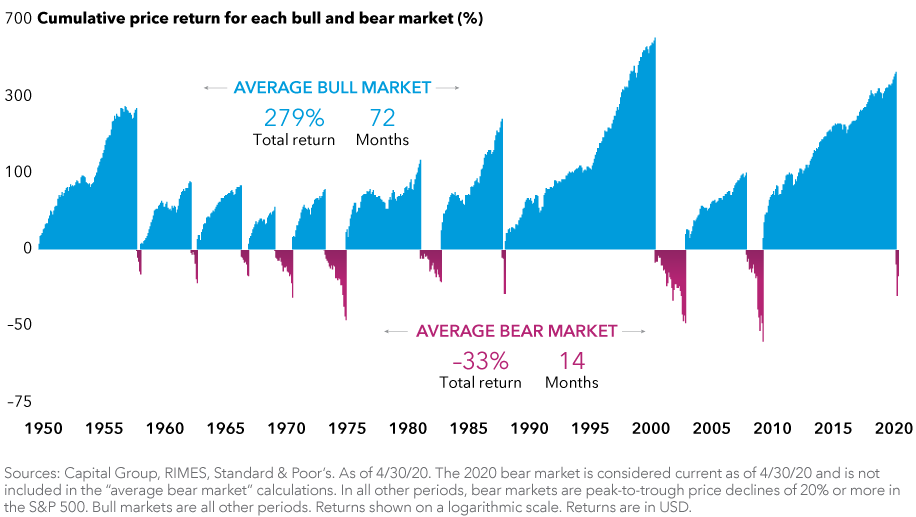
Fact #2: After large declines, markets have recovered relatively quickly
We don’t know exactly what the next recovery will look like, but history shows us that stocks have often recovered sharply following steep downturns. We tracked the 18 biggest market declines since the Great Depression, and in each case the Standard & Poor's 500 Composite Index was higher five years later. Returns over those five-year periods averaged more than 18% per year.
Returns have often been strongest after the steepest declines, bouncing back quickly from market bottoms. The first year following the five biggest bear markets over the last 90 years averaged 71%, underscoring the importance of staying invested and avoiding the urge to abandon stocks during market volatility. While these have been the average returns during these recoveries, each one has differed, and it's quite possible any future recovery could be more muted.
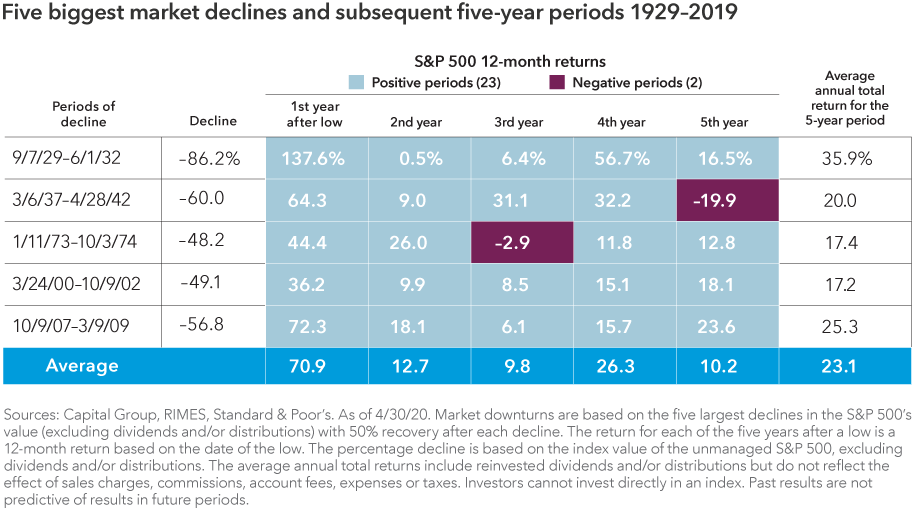
Fact #3: Some of the world’s leading companies were born during market recoveries
Many companies got their start during tough economic periods and have gone on to become household names.
To highlight just a few: McDonald’s emerged in 1948 following a downturn caused by the U.S. government’s demobilization from a wartime economy. Walmart came along 14 years later, around the time of the “Flash Crash of 1962” — a period when the S&P 500 Index declined more than 22%. Airbus, Microsoft and Starbucks were founded during the stagflation era of the 1970s, a decade marked by two recessions and one of the worst bear markets in U.S. history. Not long after that, Steve Jobs walked into his garage and started a small computer company called Apple.
History has shown that strong businesses find a way to survive and even thrive when times are tough. Those that can adapt to difficult conditions and become stronger have often made attractive long-term investments.
Bottom-up, fundamental research is key to separating which companies may help lead a market recovery, and which are more likely to be left behind.
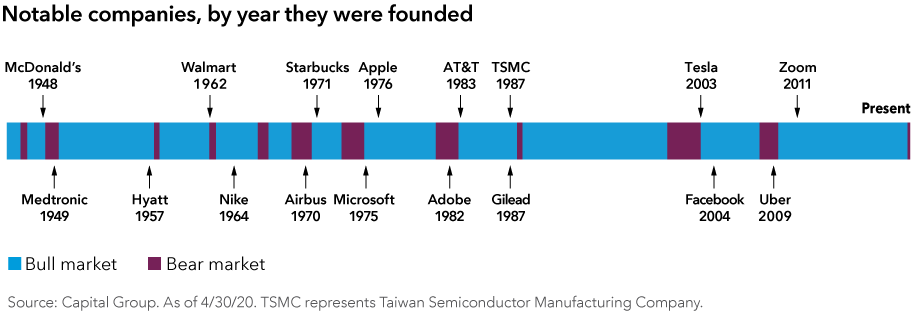
3 mistakes investors should avoid
Mistake #1: Trying to time markets
It’s time, not timing, that matters in investing. Taking your money out of the market on the way down means that if you don’t get back in at exactly the right time, you can’t capture the full benefit of any recovery.
Consider an example of a hypothetical investor who sold stocks during the market downturn of 2008–2009, and then tried to time the market, jumping back in when it showed signs of improvement. Missing even the 10 best days of the recovery would have significantly hurt that investor’s long-term results — and the more missed “good” days, the more missed opportunities.
Investors who are more hesitant to put all their excess capital to work at once may want to consider dollar cost averaging in volatile markets. Dollar cost averaging during a decline allows you to purchase more shares at a lower average cost, and when markets eventually rise, those extra shares can enhance your portfolio's value.
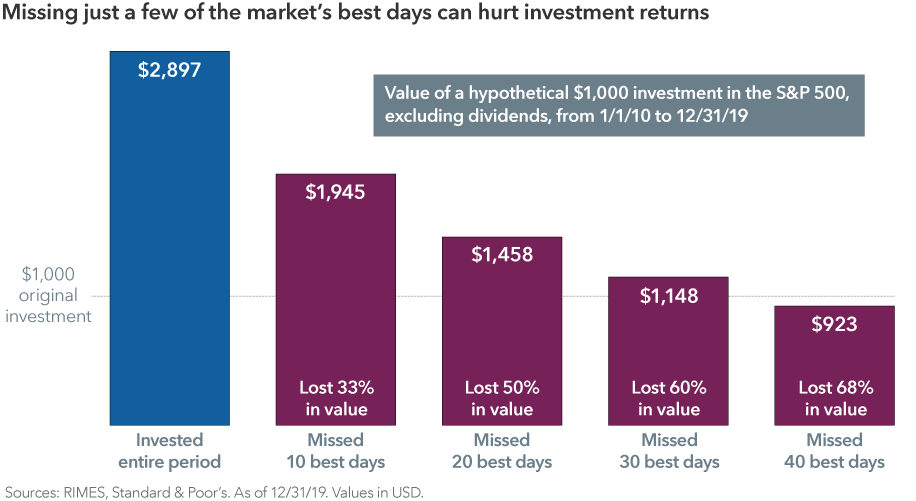
Mistake #2: Assuming today’s negative headlines make it a bad time to invest
Today’s economic and geopolitical challenges may seem unprecedented, but a look through history shows that there have always been reasons not to invest. Despite negative headlines, the market’s long-term trend has always been higher.
Consider a hypothetical investment in the S&P 500 on the day Pearl Harbor was bombed on December 7, 1941. Someone who stayed invested for the next 10 years would have averaged a 16% annual return. Likewise, a hypothetical $10,000 investment in the S&P 500 on the day Lehman Brothers declared bankruptcy on September 15, 2008, would have grown to over $30,000 10 years later. History has provided numerous examples of this.
Great investment opportunities often emerge when investors are feeling most pessimistic. The coronavirus outbreak may be unlike anything we have faced before, but uncertainty is nothing new to the market, which has been resilient over time.
Mistake #3: Focusing too much on the short term
Market volatility is especially uncomfortable when you focus on short-term ups and downs. Instead, extend your time horizon to focus on the long-term growth of your investments and the progress you’ve made toward your goals.
Consider the chart below that shows contrasting perspectives of the same hypothetical investment. The short-term view is one that many investors have of their portfolios — tracing returns over short periods of time. The long-term view plots the same exact investment over the same period, but shows annual change in the portfolio value invested instead. With this perspective, the short-term fluctuations of the first chart have smoothed out over time, and the picture of a growing portfolio becomes clearer.
Remember that bear markets don’t last forever. Maintaining a long-term perspective can help keep investors focused on the goals that matter most.

3 actions to consider in portfolios
Action #1: Run a portfolio checkup
Right now we are all focused on health and the well-being of our loved ones. This can also be a good time to check the health of your portfolio. Granted it’s hard to feel enthusiastic about investing when markets are turbulent. But after major moves in the stock market, it could be time to review your portfolio, and to ensure it is well-diversified, risk aware and aligned with investment objectives.
Capital Group can help. We offer financial professionals the opportunity to conduct an in-depth analysis with our team of portfolio consultants. And if you’re an investor, now may be a good time to talk to your financial professional about getting a checkup on your portfolio. Request a consultation from our Portfolio Consulting & Analytics team.
Action #2: Upgrade your core bonds
Even if you believe equities are set for a strong recovery, fixed income should remain an important part of your portfolio. Recoveries are often choppy, and core bonds can provide an essential measure of stability and capital preservation. With interest rates expected to remain low for years to come, it’s not too late to get your core right.
Investors don’t necessarily need to change their portfolio weightings to bonds during periods of volatility, but they should review whether their fixed income investments contain enough high-quality core bonds that can provide adequate diversification from equities.
While everyone expects the global economy to see the end of this turmoil in time, the path to recovery is still unknown. A balanced portfolio remains vital.
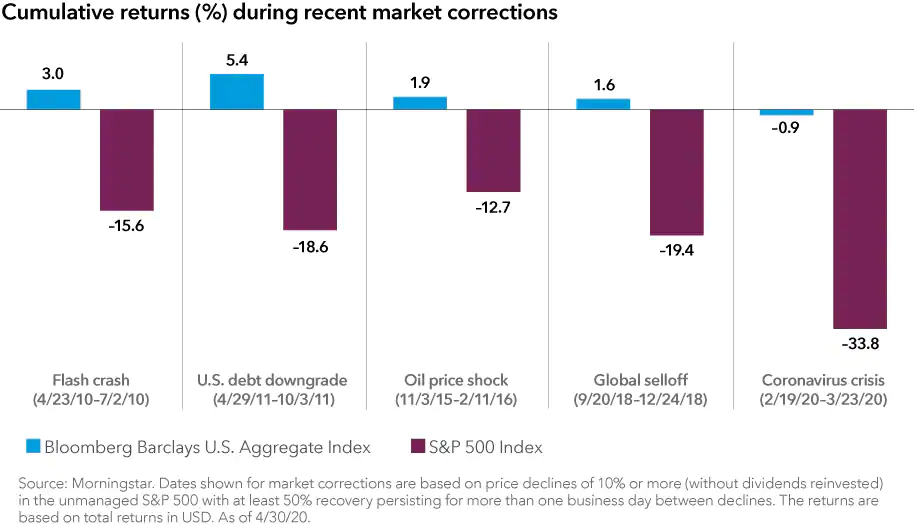
Action #3: Expand your horizons
In uncertain times, it can be natural to narrow your perspective and only focus where you’re most comfortable. But if you can broaden your horizons beyond borders, you may be able to benefit from the growth potential of great companies in a variety of industries and markets.
And even if you think U.S. markets have bottomed and are poised for a strong recovery, don’t assume all the best stocks will come from America. Over the last prolonged bull market, the S&P 500 Index soundly outpaced its international peers, but three quarters of the top-returning stocks each year were based on foreign soil.
Investors seeking additional global or international exposure may want to consider funds with flexible mandates that allow their managers to choose from the best companies, no matter where they are located.
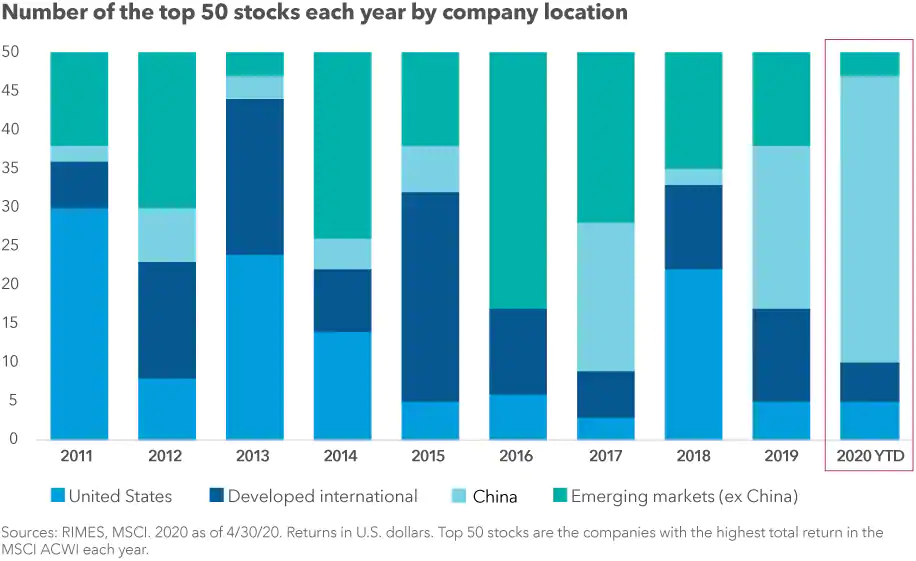
Related: 5 Steps for Managing Your Practice Through Volatility

